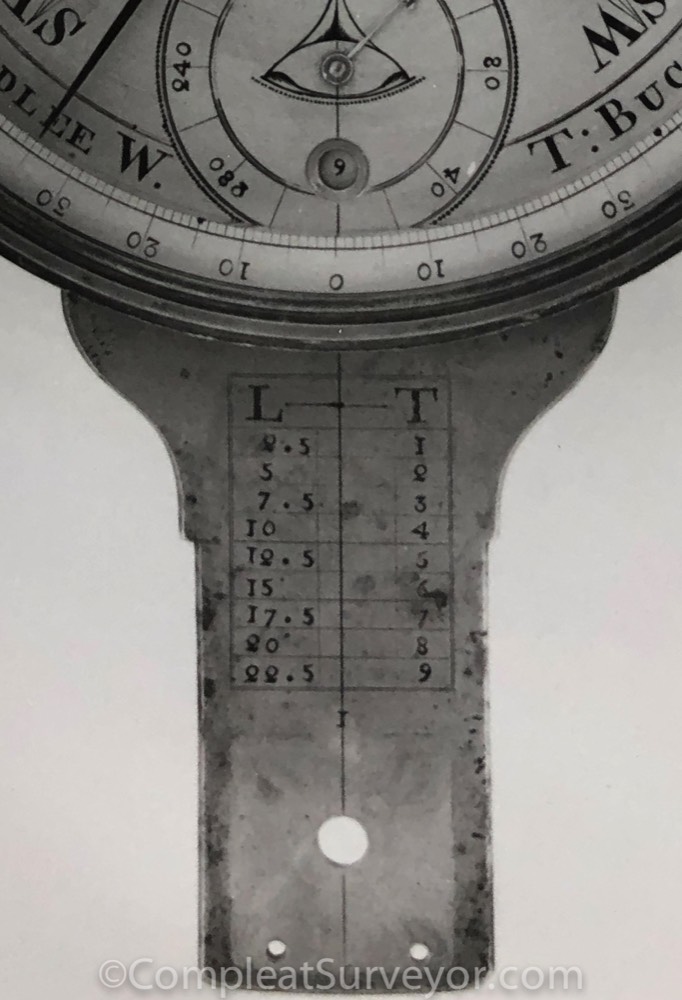The Famous Goldsmith Chandlee Links and Tenths (L-T) Table

This is the Only Known GC Compass with an Engraved Date
Goldsmith Chandlee's "L" and "T" Table
Goldsmith Chandlee's "L" and "T" Table
All known Goldsmith Chandlee compasses made after 1803 have a peculiar "L" and "T" table on the south blade or limb of the compass. A facsimile is illustrated on page 26. What is the table's purpose?
In his discussion of Goldsmith Chandlee on page 27 of The Makers of Surveying Instruments in America Since 1700, Charles Smart "surmises" that "the linear table marked L and T refer to paces L (1-1/2 feet) and T to the number of paces 1 to 9." (Smart's 1-1/2 feet is a misprint—the first tabulated "L" is the number 2.5.) So, according to Smart, this table converts paces to feet using a multiple 2.5. This explanation seems weak for three reasons: 1) "L" and "T" don't seem indicative of feet and paces; 2) The conversion of 2.5 feet per pace may be nearly correct for some people, but certainly not all; and 3) What surveyor needs a conversion table to convert paces to feet anyway? We can discount Smart's explanation. See also, Bedini - Goldsmith Chandlee & George Graves Compasses - The Professional Surveyor (Nov 1984)
Some have hypothesized that the "L" and "T" is for computing offset for some angle or variation (see With Compass and Chain, by Silvio Bedini, pp. 375, 376). Benjamin Platt (1757-1833) used a "Lks." and "Var." table for that purpose (see pages 124-127 in Smart's book). Also for that purpose see Table VII, "Correction of Randoms—Links and Minutes of Arc" in Manual of Surveying Instructions for the Survey of the Public Lands of the United States, 1894. These tables serve a different purpose than Chandlee's "L" and "T" table. See also, Bedini - Goldsmith Chandlee's L - T Table - The Professional Surveyor (May 1985) Bedini discussed a different possible explanation of GC's L - T table.
A common calculation problem of the late 1700s and early 1800s was to survey or place on the ground a metes and bounds description given in perches and tenths of perches. (A perch or pole or rod are all the same, 16.5 feet.) The measuring device of the day being a chain, there arose the need to convert perches and tenths to chains and links. One perch is 16.5 feet or a quarter of a chain or 25 links. So, one-tenth of a perch is 2.5 links. Chandlee's "L" and "T" table is an exact conversion for that use. (Tenths of perches multiplied by 2.5 equals links.) For example: to measure off a distance of 18.5 perches, the surveyor would measure four whole chains (16 perches), then measure an additional chain (two perches for a total of 18), then he would look at the table to find the remaining 0.5 perches equals 12.5 links and he would have measured the desired 18.5 perches.
Boundary retracement surveyors today practicing in the mid-Atlantic states who are familiar with the chains/links to perches/tenths conversion and vice versa (and make that conversion today) have no doubt as to the use of Chandlee's "L" and "T" table.
The above analysis is borrows heavily from Dick Elgin's EXCELLENT article - The Professional Surveyor - On Goldsmith Chandlee (2001)
Chandlee Articles
Here are some helpful reference materials related to the Chandlee Family of Instrument Makers:
1. Chandlee - Six Quaker Clockmakers (1943).
2. American Backcountry Tall Clock - Goldsmith Chandlee - His Genius His Customers (2016) A must see article that focuses on clocks and compasses.
3. The American Surveyor (Dale Beeks) - George Washington's Gift (Oct 2005) (Story about the compass Goldsmith made for GW - The Lane Compass).
4. The Professional Surveyor (Dick Elgin) - On Goldsmith Chandlee (2001) A really good article on GC.
5. Smart - His notes on Goldsmith for his book.
6. Gaynor & McKnight - Goldsmith Chandlee's "American Manufacture" Compass - The Rittenhouse Journal Vol 2 #3 (1988)
7. Beeks - A Surveyor's Compass Made By Goldsmith Chandlee - The Rittenhouse Journal Vol 2 #3 (1988)
8. Bedini - Goldsmith Chandlee & George Graves Compasses - The Professional Surveyor (Nov 1984) - Relying on Smart, Bedini inaccurately describe the functions of GC's L - T Table.
9. Bedini - Goldsmith Chandlee's L - T Table - The Professional Surveyor (May 1985) Bedini discussed a different possible explanation of GC's L - T table. I believe that Dick Elgin came up with the right explanation in his article, #4 above.
© 2020 Russ Uzes/Contact Me